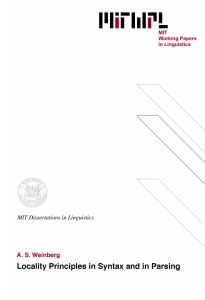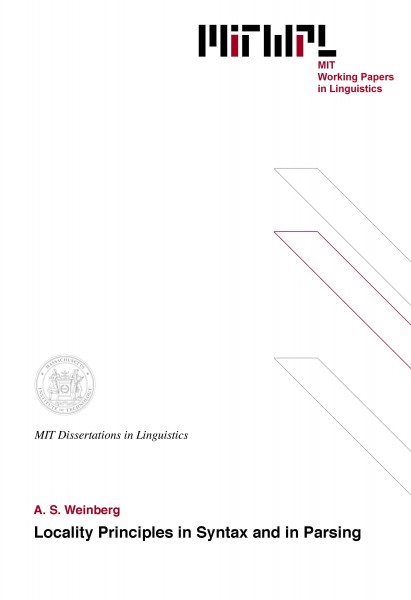Locality Principles in Syntax and in Parsing
A. S. Weinberg, 1988
This thesis has three main aims. The first is to present criteria that can be used to constrain the class of natural language comprehension devices. We argue that a certain class of parsers: LR(k) bounded context processors can explain why grammars for natural languages must contain a Subjacency constraint. More generally, we argue that the ability to provide a functional explanation for linguistic constraints is a major criterion for judging the adequacy of classes of processing devices. In service of the first goal, we also consider several psycholinguistic experiments that have been taken as incompatible with the LR(k) approach and show that a more refined LR(k) theory (the Minimal Commitment Theory) can deal with these cases in an illuminating way.
Our second aim is to show that the theory of parsing forms an integral part of grammatical theory not only in the sense of providing a functional motivation for one of the theory’s major constraints, but also in its ability to explain otherwise mysterious properties of subjacency. In particular, I claim that a parsing theoretic approach can explain why subjacency applies at S-structure, why it applies to movement, parasitic gaps, and a subset of gapping structures even though these structures do not constitute a natural class given only formal or linguistic sunstantive criteria. thus the theory of parsing become an integral part of grammatical theory in that it, just like the functional demand of language learning dictates the form that grammars of natural languages can take.
The final aim of this theory is to propose an adequate formal theory of Subjacency and the Empty Category Principle, (ECP). Following WAHL (forthcoming), I propose to separate the ECP into two parts: a condition of lexical government and generalised binding. These conditions apply conjunctively and in separate parts of the grammar. I argue for this approach by considering superiority effects and other “WH in situ” constructions. These conditions interact with the proposed subjacency constraint in that subjacency forces overt syntactic movement to be local. Local movement is allowed only if its output can satisfy both parts of the ECP. We argue that this approach yields a revealing treatment of the standard syntactic island effects, the Condition on Extraction Domains, movement from NPs, and the parasitic gap construction.
Thesis supervisor: Noam Chomsky
Title: Institue Professor
Table of Contents
I Introduction 7
II Constraints on the class of natural language processors: experimental
results, determinism, and bounded context parsing 13
2.1 Classes of processing devices 14
2.2 On the simulation of perceived processing complexity 17
2.3 Empty operators and non-parallel processors 22
2.4 Left context and the analysis of operator variable structure 28
2.5 The Minimal Commitment Theory 36
2.6 An apparent problem for non-backtracking models 45
2.7 Some advantages of the Minimal Commitment Theory over
backtracking and parallel devices 48
2.8 Conclusion 59
Footnotes to Chapter 2 61
III Subjacency and the deterministic model 67
3.1 Introduction 67
3.2 Bounded context parsing 70
3.3 The problem of ambiguity and left context for bounded context
parsers 75
3.4 Parasitic gaps 82
3.5 Licensing of parasitic gaps 88
3.6 On the distribution of epithets 90
3.7 Critical remarks 94
3.8 Gapping constructions 98
3.8.1 Description of the problem 98
3.8.2 Ambiguity and gapping 103
3.8.3 Complement and adjunct attachment 110
3.8.4 Subjacency as an S-structure condition 112
3.8.5 Subjacency as a natural condition on grammars 115
3.9 Bounding conditions in LF 117
3.10 Conclusion 126
Footnotes to Chapter 3 128
IV Two versions of locality 136
4.1 The Barriers theory of government and proper government 137
4.2 The WAHL framework 149
4.3 Conclusion 172
Footnotes to Chapter 4 174
V Two notions of bounding 185
5.1 Bounding in the Barriers framework 185
5.2 Bounding in the WAHL framework 192
5.3 Concluding remarks 207
Footnotes to Chapter 5 210
VI A comparison of the Barriers and WAHL frameworks 214
6.1 Superiority 215
6.2 Pronouns as bound variables revisited 223
6.3 General theoretical consequences of the account
6.3.1 Movement from NPs 229
6.3.2 Movement from NPs in romance 237
6.4 Conclusion 244
Footnotes to Chapter 6 246
VII On the distribution of parasitic gaps 254
7.1 Introduction 254
7.2 Indexation within the Wahl framework 256
7.3 Subjacency and parasitic gaps 257
7.4 The Barriers approach to parasitic gaps 263
7.5 Anti-C-command and parasitic gap licensing 267
7.6 S-structure licensing 272
7.7 A surprising asymmetry 273
7.8 Other approaches 274
7.9 Conclusion 278
Footnotes to Chapter 7 280

